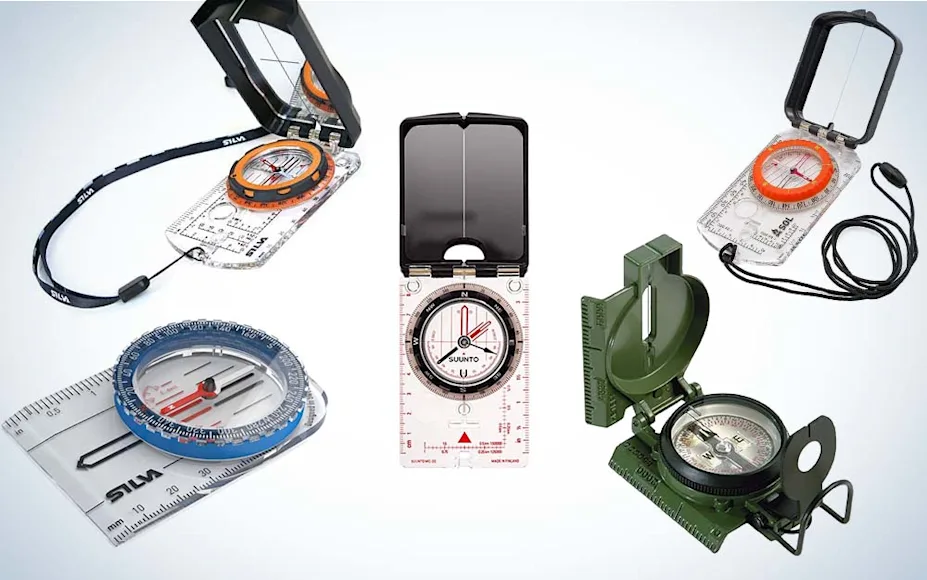_We may earn revenue from the products available on this page and participate in affiliate programs. Learn more ›
_
Best Overall
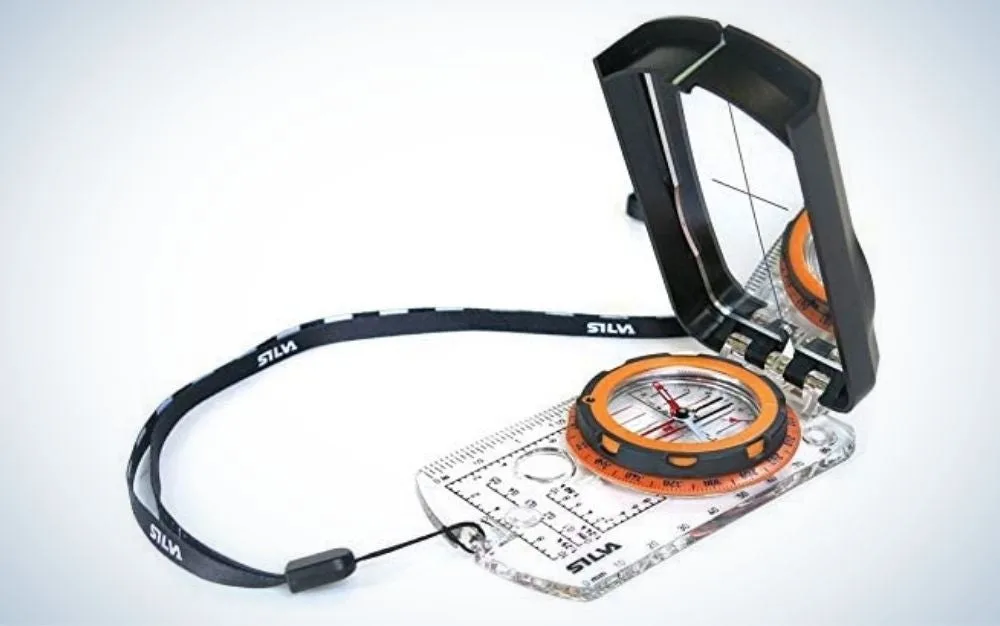
Silva Ranger 2.0
LEARN MORE
Summary
Loaded with bells and whistles, the Silva Ranger 2.0 has everything you’ll need to orient in the wild.
Best Budget
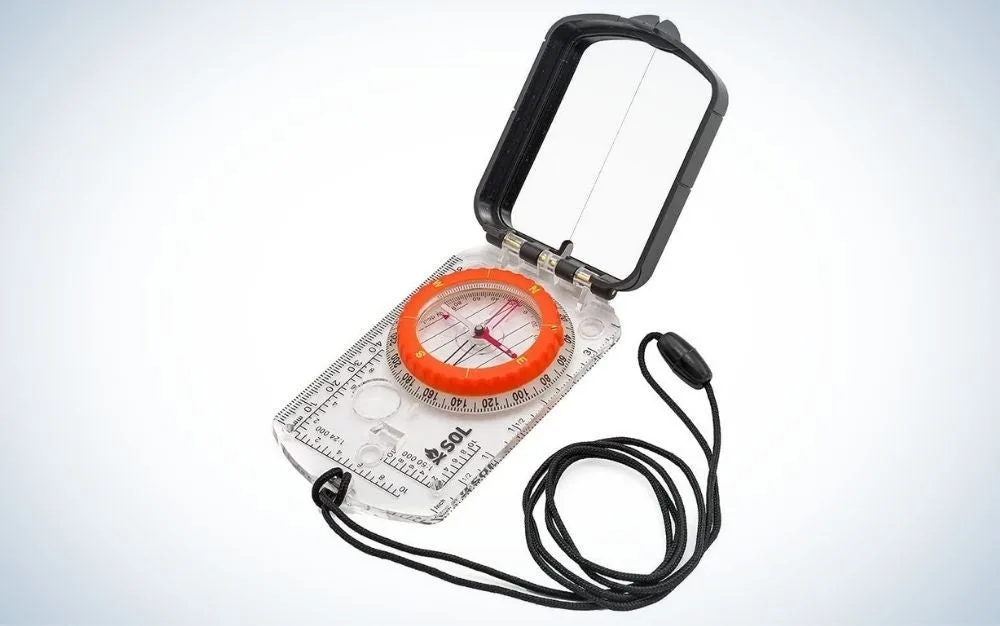
Survive Outdoors Longer (S.O.L.) Sighting Compass with Mirror
LEARN MORE
Summary
This budget compass has most of the features of high-end models, including night navigation capability, clinometer, and adjustable declination.
Most Durable
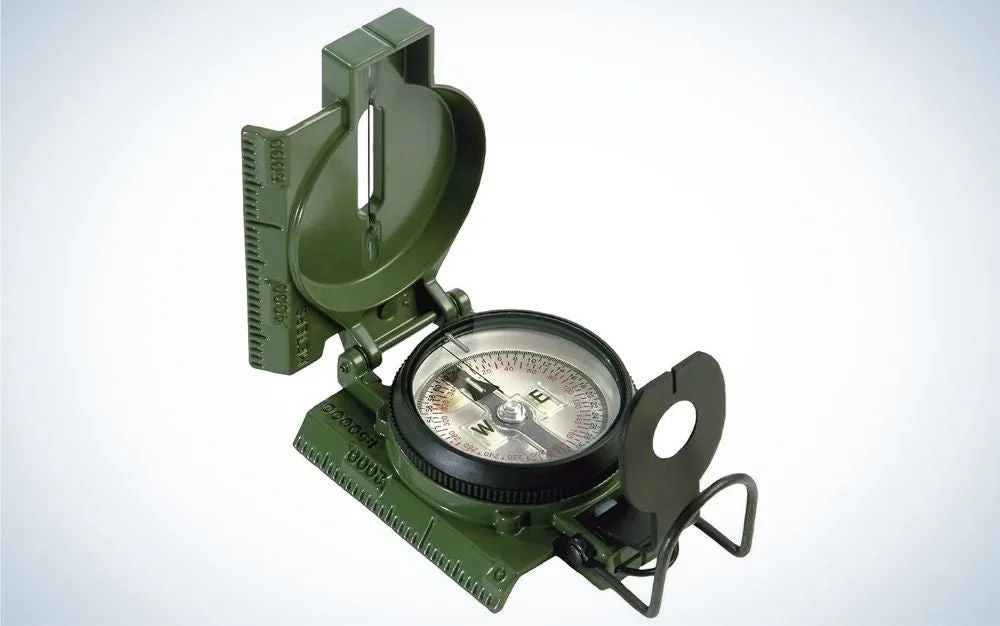
Cammenga 3H Cammenga G.I. Military Lensatic Compass
LEARN MORE
Summary
Trusted by the U.S. military for its durability and precision, this compass can handle extreme temperature, water, shock, and sand.
The best compass is one that you know how to use and have with you. It can help you take a bearing of a distant object, follow a route through wilderness, and orient yourself on a map. Even if you prefer digital navigation aids, like a handheld GPS
, you should always have a compass on hand to ensure you never lose your bearings if the GPS runs out of battery power. Whether you are a novice to the world of orienteering or looking to level up, here are some things to consider before making your purchase of the best compass for hiking.
Best Overall: Silva Ranger 2.0
Best Budget: Survive Outdoors Longer (S.O.L.) Sighting Compass with Mirror
Most Durable: Cammenga 3H Cammenga G.I. Military Lensatic Compass
Best for Kids and Beginners: Silva Starter 1-2-3
Best for Travel: Suunto MC-2G Global Compass
How We Picked the Best Compasses for Hiking
As an avid hiker and wilderness adventurer, I recognize that the compass is one of the most important essentials in my backpack. Even though it’s packed most of the time, I know it could easily save my life someday if I become lost, disoriented, or forced to maneuver off trail.
My compass expertise sharpened over the years I taught orienteering courses for Appalachian Mountain Club’s Mountain Classroom program. I gained experience by teaching compass skills and setting up compass orienteering challenge courses in the woods. I have spent many seasons getting to know my way around a compass.
In choosing the best compass for hiking, I looked at a few main criteria:
Quality: There are plenty of affordable plastic compasses out there, but in a real bind, you want to have the assurance that your instrument will get you to where you need to go. If it’s a matter of life or death, the best compass is the one that will be reliable and trustworthy.
Features: While a beginner needs few features so they can learn the basics, an experienced orienteer should choose a compass with features that make their instrument a multi-use tool. Mirrors, rulers, magnifying glass, and lanyards can have other uses in the field for first aid, survival, and hygiene.
Durability: If you’re throwing your compass into your hiking backpack
for the day, it’s important that it’s durable enough to survive the trek. I looked for compasses that were waterproof, protected, and proven industry leaders.
Best Compasses for Hiking: Reviews and Recommendations
Best Overall: Silva Ranger 2.0
Best Overall

Silva Ranger 2.0 Silva
Specs
Type: Mirrored baseplate
Weight: 3.88 oz
Dimensions: 5 x 11 x 2 in
Materials: Plastic
Pros
Sighting mirror
Lanyard with distance measurements
Declination adjustment with included tool
Cons
Complicated features not good for beginner
The Silva Ranger 2.0 is a quality mirrored baseplate compass that is the perfect fit for hiking, bushwhacking, hunting, or forestry. If you are comfortable with mirrored baseplate compass use, it is the best compass for hiking.
This compass includes a mirror for sighting. By tilting the mirror at 45° angle, the user can keep an eye on the needle by looking at the bezel in the mirror while sighting the direction. This is especially helpful over long distances.
In addition, the Ranger comes with a magnifying glass, luminous markings, and a separate “slope card”. Experienced hikers can use the slope card to measure grade on a map or assess avalanche risk.
The lanyard of the Ranger 2.0 is unique in that it has four scales of measurement to help the hiker measure distances on a map. Since it is soft, it’s more useful than a straightedge when tracing a path on a map.
The adjustable declination of this compass allows the hiker to adjust the compass to their location. This saves time as well as reducing the possibility of user error when adjusting for declination with each bearing.
While the bells and whistles of this compass are sweet, they can also be overwhelming. If you are new to orienteering and looking for something the same quality but less overwhelming, try the Silva Explorer
. It’s a quality baseplate compass that will help a hiker with basic orienteering.
Best Budget: Survive Outdoors Longer (S.O.L.) Sighting Compass with Mirror
Best Budget

Survive Outdoors Longer (S.O.L.) Sighting Compass with Mirror S.O.L. Survive Outdoors Longer
Specs
Type: Mirrored baseplate
Weight: 3.53 oz
Product Dimensions: 5.5 x 3.94 x 0.79 in
Materials: Plastic
Pros
Clinometer
Low light visibility
Declination adjustment with included tool
Cons
Less Durable
If you’re looking for an affordable compass that still comes with the bells and whistles of its higher price competitors, the Survive Outdoors Longer (S.O.L) Sighting Compass with Mirror is the best budget compass.
This is a mirrored baseplate compass that is great for hiking or bushwhacking. Some of the notable features include a mirror, rulers in both millimeter and inches, and magnifying glass. Luminous markings on the orienting arrow, needle, and direction of travel marking glow in the dark after briefly being exposed to a light (like your flashlight).
The SOL compass also has a clinometer on the baseplate that allows you to measure a slope angle.
One of the most useful features of this compass is the ability to adjust declination. A small tool comes with the compass that allows you to fine-tune the bezel to compensate for declination and calculate your bearing with the proper offset for your region every time.
Although this compass has held up well, its materials appear far less durable than its Silva and Suunto counterparts. My only real complaint is that I find the bezel ring a little tough to spin. Nevertheless, this compass is great value. The fold down mirror protects the compass when not in use so you don’t have to worry about it being destroyed in your pack.
Most Durable: Cammenga 3H Cammenga G.I. Military Lensatic Compass
Most Durable

Cammenga 3H Cammenga G.I. Military Lensatic Compass Cammenga
Specs
Type: Lensatic
Weight: 7.04 oz
Dimensions: 6 x 6 x 6 in
Materials: Aluminum
Pros
Durable
Precise
Low light capability
Cons
No declination adjustment capability
Similar to the compass used by the US military, the Cammenga Lensatic Compass is great for shooting a line to a distant object using a sight wire. This is helpful for tracking a route back to your car after a day in the woods or crossing wilderness using azimuth.
This model has some serious benefits that make it a favorite of military and civilians alike. The tough aluminum casing means it is durable and easy to toss into your pack. The housing is air filled which means the needle is more sensitive to movement but will not develop bubbles in the housing.
Perhaps most importantly, this compass comes with tritium lighting — a radioactive phosphorescence that glows in the dark (don’t worry, it’s not harmful with the amount used). This makes the Cammenga the best compass for night use as well.
While this compass is great for finding and following a sight bearing, it’s challenging to use with a map. There are no magnetic declination adjustments which makes it difficult to account for actual north. The main measurement of this compass is in Mils (short for mili-radians) whereas most hikers prefer degrees. Also, it doesn’t have grid lines like the baseplate compasses so it is challenging to line up with the grid. Still, it’s hard to argue that there is a more durable field compass on the market. If the price tag has you sweating, consider the more affordable 9077 Lensatic Military-Style Compass from Brunton
.
Best for Kids and Beginners: Silva Starter 1-2-3
Best for Kids and Beginners
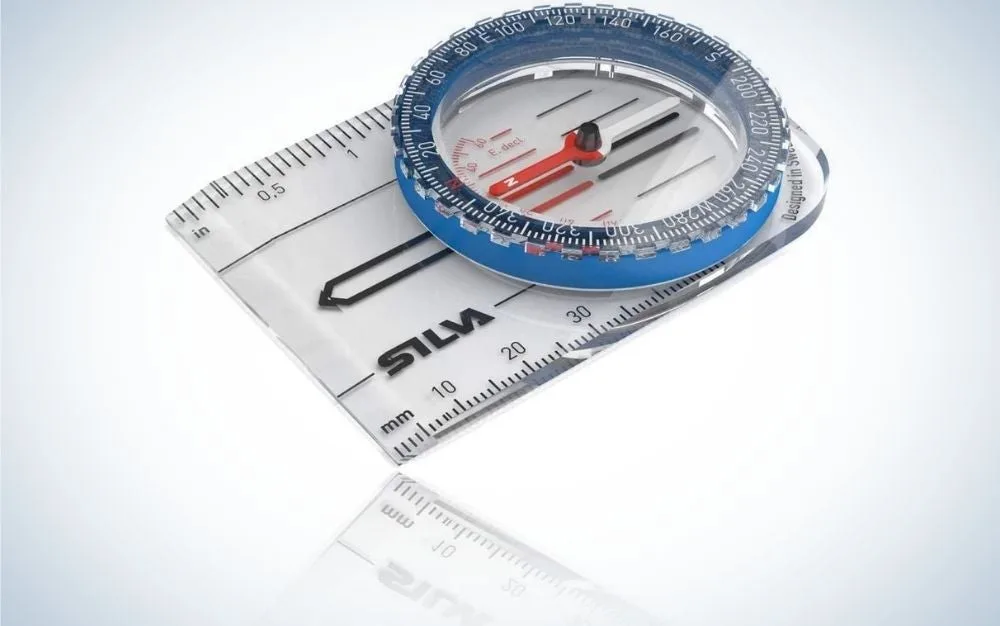
Silva Starter 1-2-3 Silva
Specs
Type: Baseplate
Weight: 1.4 oz
Dimensions: 2 x 3 x 0.4 in
Materials: Plastic
Pros
Easy to use
Waterproof
Lightweight
Cons
No declination adjustment capability
If you are looking for a simple and sleek starter compass, the Silva Starter 1-2-3 is your best bet. The compass is small and light with an easy-to-read housing. It’s also waterproof which makes it a durable choice to bring into the field.
This starter compass is high quality with few bells and whistles. This helps beginners focus on the basics and not get overwhelmed by features on mirrored baseplate counterparts. There are mm and inch ruler markings on the side of the baseplate and clear degree parks on the bezel.
The bezel ring is fairly large and turns really smoothly. This is perfect for children and others learning the basics, easily putting “red in the shed” and orienting the compass.
Being so simple, this compass does not come with declination adjustment capacity so users pairing this with a map would need to adjust each bearing for declination. Overall, it is exactly what it’s supposed to be: a great starter compass.
Best for Travel: Suunto MC-2G Global Compass
Best for Travel
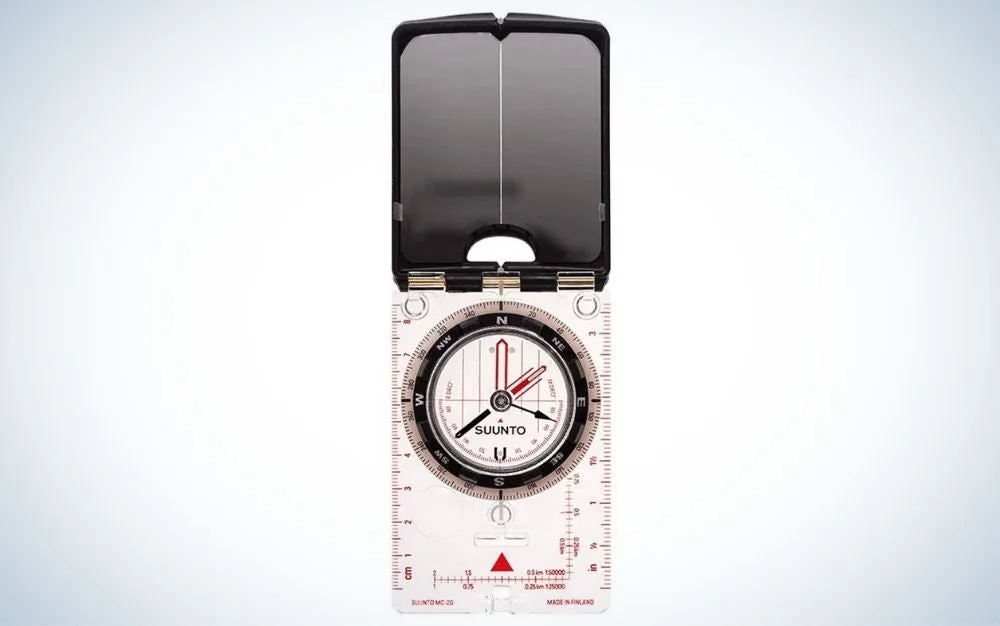
Suunto MC-2G Global Compass SUUNTO
Specs
Type: Mirrored baseplate
Weight: 2.65 oz
Dimensions: 2.56 x 3.98 x 0.71 in
Materials: Plastic and stainless steel
Pros
Global needle
Clinometer
Declination adjustment with included tool
Cons
Expensive
Compasses are usually created to work in their specific hemisphere (north or south). However, Suunto’s “global needle” works in both, so whether you’re trekking through a U.S. national park, climbing a peak in New Zealand, or crossing glaciers in Patagonia, this compass will do the job. This makes the Suunto MC-2G Global Compass the best compass for travel.
This instrument also comes with all the extras. The signing mirror, ruler, clinometer, and magnifying lens are all useful tools that a seasoned compass-user will find valuable. Another feature that makes navigating on a hike much easier is the ability to adjust declination to the area. The lanyard has a small adjustment key attached so you can adjust your declination to every new location traveled. This compass also comes with luminous points and bezel for low light navigation.
While the MC-2G is about as loaded with features as you can get, it is a tool for an experienced user and could easily overwhelm a newbie. If you are looking for a simpler model that can still take on both hemispheres (and half the cost), consider the Silva Ranger Global Compass
. It can be used in all three magnetic zones and has the same simple features you see on the Silva Starter.
What to Consider When Choosing a Compass for Hiking
Types of Compasses
Before you look at brands or features on a compass, it’s important to know the types available
. There are three main types of hiking compasses: baseplate, mirrored baseplate, and lensatic. All can be used to orienteer through wilderness. Here’s a quick breakdown:
Baseplate Compass: A baseplate compass is great for hiking since it pairs well with a map. As the name implies, a liquid filled housing contains the needle and sits on a clear baseplate. The liquid allows the needle to move slowly and smoothly. The clear baseplate permits you to see through to the map to set waypoints and align the compass to north. The plate usually has a straightedge on the side for drawing lines between waypoints and a ruler to determine distances.
Mirrored Baseplate Compass: The addition of the mirror on a traditional baseplate compass adds versatility, allowing the user to see the compass dial and the background at the same time. The mirror opens with the hinge at the direction-of-travel arrow, and there is usually a v-notch on the base of the mirror that the user can use as a sight for finding objects in the field. By keeping the mirror at a 45° angle, you can align the compass to a target by looking through the notch then by looking at the mirror align the orienting arrow to the north arrow. This adds accuracy but can also add challenge. Therefore, a typical baseplate compass is better for beginners.
Lensatic Compass: Also known as the military compass, the lensatic compass is a great companion to those who know how to use it. They are usually air-filled, which results in a faster moving needle and more durable compass. This compass type is mainly used to get a site bearing and are more challenging to use with a map. However, the military lensatic compass is durable, has night capacity, and greater precision than its baseplate companions.
Features to Look For
Most compasses come with the same basic features including a needle that points to magnetic north, direction of travel arrow, and moveable bezel ring. However, the best compasses for hiking add a few more features that make them a multi-use tool. Here are some additional items that will make the compass even better.
Mirror: As mentioned above, some baseplate compasses come with a mirror. While it can help with accuracy, the mirror can also double as a signaling device as well as serving as a hygiene mirror for first aid in the wilderness.
Magnifying Lenses: Some baseplate and lensatic compasses come with a small magnifying lens. This is helpful when reading fine print on a map and can be used as a tool for fire starting.
Glow in the Dark Indicators: Luminescent markings are usually made from strontium-alumina based pigments and can help you make your way in the dark.
Declination Adjustment: Gridlines on maps are aligned to geographic north while the compass is oriented to magnetic north. If you don’t account for this difference, you’ll be off course. Some baseplate compasses come with a declination screw that can be adjusted to match that of your region. This allows the user to change the declination to match the area. It’s very useful for backcountry navigation with a map.
Clinometer: A small moving arrow in the liquid-filled housing allows the user to measure slope and steepness.
Global Needle: If you plan to take your compass into the southern hemisphere, be sure to get one with a global needle that is designed for both hemispheres.
FAQs
Q: Is a liquid filled compass better?
A liquid filled compass isn’t necessarily better, but it does have its benefits. Most baseplate compasses are liquid filled, which means the needle is rotating through a liquid. This slows the needle, making it less sensitive to movement in your hand. But aggressive movements, such as bumping around in your bag or drops, can develop bubbles in the liquid or create leaks which will impede the accuracy of the compass. Some liquid filled compasses are also sensitive to temperature extremes.
Q: What should I look for in a hiking compass?
If you are new to hiking compasses, you should look for a user-friendly design that’s easy to use. Make sure your basic hiking compass has:● A clear baseplate for seeing a map underneath● Easily moveable bezel ring● Clearly marked direction of travel arrow● Needle that orients to magnetic north● Orienting arrow and lines
Q: How much does a good compass cost?
Compass price varies wildly depending on quality and features. A good compass can cost anywhere from $15 to $100. A solid, reliable hiking compass like the Silva Explorer
or Suunto A-30
fall into the $20 to $30 range. If taken care of, these can last for a lifetime of adventures.
Q: Do compasses lose accuracy?
It is possible for the needle in your compass to demagnetize over time if you store it near a strong magnet. However, the most likely need for a new compass is wear and tear from being crammed into a backpack, falling onto rocks, or tolerating extreme swings in temperature. If taken care of, a good compass could easily last a lifetime.
Best Compasses for Hiking: Final Thoughts
Best Overall: Silva Ranger 2.0
Best Budget: Survive Outdoors Longer (S.O.L.) Sighting Compass with Mirror
Most Durable: Cammenga 3H Cammenga G.I. Military Lensatic Compass
Best for Kids and Beginners: Silva Starter 1-2-3
Best for Travel: Suunto MC-2G Global Compass
Whether you are headed into the woods on a hunt, staying on a hiking route, picking out a peak on a map, or following a course – the best compass is one you know how to use and keep on your person. Make sure one is tucked into your bag on every adventure.
Why Trust Us
For more than 125 years, Field & Stream has been providing readers with honest and authentic coverage of outdoor gear. Our writers and editors eat, sleep, and breathe the outdoors, and that passion comes through in our product reviews. You can count on F&S to keep you up to date on the best new gear. And when we write about a product—whether it’s a bass lure or a backpack—we cover the good and the bad, so you know exactly what to expect before you decide to make a purchase.

